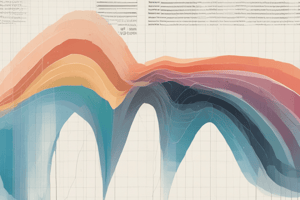Podcast
Questions and Answers
What is the primary purpose of using pie charts for data visualization?
What is the primary purpose of using pie charts for data visualization?
- To show the total value of the data
- To show proportions between different categories (correct)
- To provide a detailed breakdown of the data
- To compare numerical values across different categories
What is the key characteristic of the sectors in a pie chart?
What is the key characteristic of the sectors in a pie chart?
- The sectors have varying angles
- The sectors have uniform angles (correct)
- The sectors are arranged in a bar format
- The sectors are arranged linearly
What is the central angle in a pie chart?
What is the central angle in a pie chart?
- The angle between the center and the outer edge of the pie
- The angle between the horizontal axis and the vertical axis
- The angle between two adjacent sectors (correct)
- The angle between the pie and the surrounding frame
What is the starting point of a pie chart?
What is the starting point of a pie chart?
What is the primary component of a pie chart?
What is the primary component of a pie chart?
What is the key factor to consider when interpreting a pie chart?
What is the key factor to consider when interpreting a pie chart?
Study Notes
Pie Graphs
A pie graph is a circular statistical graphic which is divided into slices to illustrate numerical proportion. It's called a 'Pie Percentage Chart'. In a typical pie chart of percentage data, each slice represents a value. All values represented by equal angles, so when their sum is 360 degrees the arcs connect back to the center at 12 o'clock.
Data Visualization
The purpose of using pie charts for data visualization is to show proportions between different categories in qualitative terms. They are primarily used for representing whole parts out of total parts like fractional representation, percentages etc. The pie chart is best suited for showing how individual elements contribute to a whole, with a starting point of zero and passing around in a circle until all the sections are complete.
Components of Pie Charts
A pie chart consists of several sectors arranged radially along a circle, where each sector represents one category of data being shown. These sectors have uniform angles so that when they add up to 360 degrees, the arc connecting them passes through the center at 12 o'clock. The central angle is split into multiple segments, each corresponding to a particular data segment of the given data set.
Interpreting Pie Charts
To interpret a pie chart, you need to understand the context of what is being analyzed as well as the scale of the categories involved. If there is space within the chart, it can also include labels on each section indicating the percentage that it holds over the entire dataset. By comparing the size of the sections relative to each other, you can determine which categories dominate the overall composition and gain insights into relationships among different aspects of your data.
In conclusion, pie graphs serve as valuable tools in data visualization by providing a clear depiction of numerical proportions among various categories. Their simplicity makes them ideal for understanding complex datasets, especially when dealing with simple fractions or percentages.
Studying That Suits You
Use AI to generate personalized quizzes and flashcards to suit your learning preferences.
Description
Learn about pie graphs, also known as pie percentage charts, and how they visually represent numerical proportions in data. Discover the components of pie charts and how to interpret them effectively to gain insights into different data categories.




